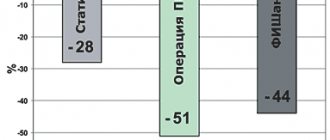Fevarin®
As with the use of other psychotropic drugs, it is not recommended to consume alcohol during treatment with Fevarin®.
Depression is associated with an increased risk of suicidal ideation, self-harm, and suicide attempts (suicidal behavior). This risk persists until the condition significantly improves. Since improvement may not occur within the first few weeks of treatment or longer, patients should be closely monitored until such improvement occurs.
Increased risk of suicide in the early stages of recovery is widespread in clinical practice.
Other psychiatric disorders for which fluvoxamine is prescribed may also be associated with an increased risk of suicidal behavior. In addition, these conditions may accompany major depression. Therefore, patients with other mental disorders should be closely monitored.
Patients with a history of suicidal behavior or a significant degree of suicidal ideation are known to be at greater risk of suicidal ideation or suicide attempts before treatment and should be closely monitored during treatment.
Careful monitoring of patients, especially those at high risk, should accompany drug therapy, especially in its early stages and after dose changes.
Patients (and their caregivers) should be warned to monitor for any clinical deterioration, suicidal behavior or thoughts, or unusual changes in behavior, and to immediately seek professional advice if such symptoms occur.
The development of akathisia associated with fluvoxamine is characterized by subjectively unpleasant and painful anxiety. The need to move was often accompanied by an inability to sit or stand still. The development of this condition is most likely during the first few weeks of treatment. Increasing the dose of the drug in patients with such symptoms may worsen their condition.
Caution should be exercised when prescribing the drug to patients with a history of seizures. Fluvoxamine should be avoided in patients with unstable epilepsy, and patients with stable epilepsy should be closely monitored. Treatment with Fevarin® should be discontinued if epileptic seizures occur or their frequency increases.
Rare cases of serotonergic syndrome or NMS-like conditions have been described and may be associated with fluvoxamine, especially in combination with other serotonergic and/or antipsychotic drugs. These syndromes can lead to potentially life-threatening conditions manifested by hyperthermia, muscle rigidity, myoclonus, autonomic nervous system lability with possible rapid changes in vital parameters (including pulse, respiration, blood pressure), mental status changes including confusion, irritability, extreme agitation, reaching delirium or coma. Therefore, in such cases, Fevarin® should be discontinued and appropriate symptomatic treatment should be started.
As with the use of other selective serotonin reuptake inhibitors, in rare cases hyponatremia may occur, which reverses after discontinuation of fluvoxamine. Some cases have been caused by ADH deficiency syndrome. These cases were mainly observed in elderly patients.
Blood glucose control may be impaired (ie, hyperglycemia, hypoglycemia, impaired glucose tolerance), especially early in treatment. If Fevarin® is prescribed to patients with a history of diabetes mellitus, dose adjustment of hypoglycemic drugs may be required.
The most commonly observed symptom associated with the use of Fevarin® is nausea, sometimes accompanied by vomiting. This side effect usually disappears within the first 2 weeks of treatment.
Cases of mydriasis have been reported with the use of SSRIs such as fluvoxamine. Therefore, patients with elevated intraocular pressure or patients at increased risk of acute angle-closure glaucoma should be prescribed fluvoxamine with caution.
There are reports of intradermal hemorrhages such as ecchymosis and purpura, as well as other hemorrhagic manifestations (for example, gastrointestinal bleeding or gynecological bleeding), observed with the use of selective serotonin reuptake inhibitors. Caution should be exercised when prescribing these drugs in elderly patients and patients concomitantly receiving drugs that affect platelet function (for example, atypical antipsychotics and phenothiazines, many tricyclic antidepressants, acetylsalicylic acid, NSAIDs) or drugs that increase the risk of bleeding, as well as in patients with a history of bleeding or prone to bleeding (for example, thrombocytopenia or coagulation disorders).
Increased risk of prolongation of the QT interval/paroxysmal ventricular tachycardia of the "pirouette" type during combination therapy with fluvoxamine with terfenadine or astemizole or cisapride, due to an increase in the concentration of the latter in the blood plasma. Therefore, fluvoxamine should not be coadministered with these drugs.
Fluvoxamine may cause a slight decrease in heart rate (by 2-6 beats/min).
There is limited clinical experience with the use of fluvoxamine in conjunction with ECT, so such therapy should be carried out with caution.
When you stop taking fluvoxamine, withdrawal syndrome may develop, although available data from preclinical and clinical studies have not revealed the occurrence of dependence on fluvoxamine treatment. The most common symptoms noted in case of drug withdrawal: dizziness, sensory disturbances (including paresthesia, visual disturbance and electric shock sensation), sleep disturbances (including insomnia and vivid dreams), agitation, irritability, confusion, emotional lability, headache, nausea and /or vomiting, diarrhea, sweating, palpitations, tremors and anxiety. Most of these symptoms are mild or moderate and self-limiting, but in some patients they can be severe and/or prolonged. These symptoms usually occur within the first few days after stopping treatment. For this reason, it is recommended to gradually reduce the dose of fluvoxamine before complete discontinuation according to the patient's condition.
Fluvoxamine should be used with caution in patients with a history of mania/hypomania. If the patient develops a manic phase, fluvoxamine should be discontinued.
Treatment of patients with liver or kidney failure should begin with the drug in a low dose; such patients require strict medical supervision. In rare cases, treatment with fluvoxamine may lead to an increase in liver enzyme activity, which is most often accompanied by corresponding clinical symptoms; in such cases, Fevarin® should be discontinued.
Data obtained from the treatment of elderly patients and younger patients indicate that there are no clinically significant differences between the daily doses usually used in them. However, dose increases in elderly patients should always be done more slowly and with greater caution.
A meta-analysis of placebo-controlled clinical trials of antidepressants in adult patients with mental disorders found an increased risk of suicidal behavior with antidepressants compared with placebo in patients younger than 25 years. When prescribing fluvoxamine, the risk of suicide should be weighed against the benefits of its use.
Use in pediatrics
Fluvoxamine should not be used to treat children and adolescents under 18 years of age, with the exception of patients with obsessive-compulsive disorder. Due to the lack of clinical experience, the use of fluvoxamine in children for the treatment of depression cannot be recommended. In clinical studies conducted among children and adolescents, suicidal behavior (suicidal attempts and thoughts) and hostility (mainly aggression, oppositional behavior and anger) were observed more often in patients receiving an antidepressant compared to those receiving placebo. If a treatment decision is made based on clinical need, the patient should be closely monitored for the emergence of suicidal symptoms.
Additionally, long-term safety data for children and adolescents regarding growth, development, and cognitive development are lacking.
Impact on the ability to drive vehicles and operate machinery
When used in healthy volunteers, Fevarin® in doses up to 150 mg did not affect or had an insignificant effect on the ability to drive a car and control machines. At the same time, there are reports of drowsiness noted during treatment with fluvoxamine. In this regard, until the final determination of the individual response to the drug, patients are advised to exercise caution when engaging in potentially hazardous activities.





